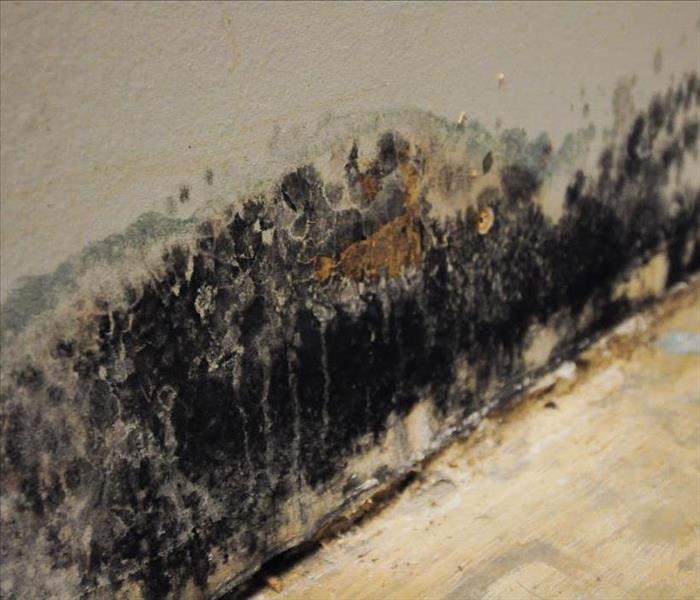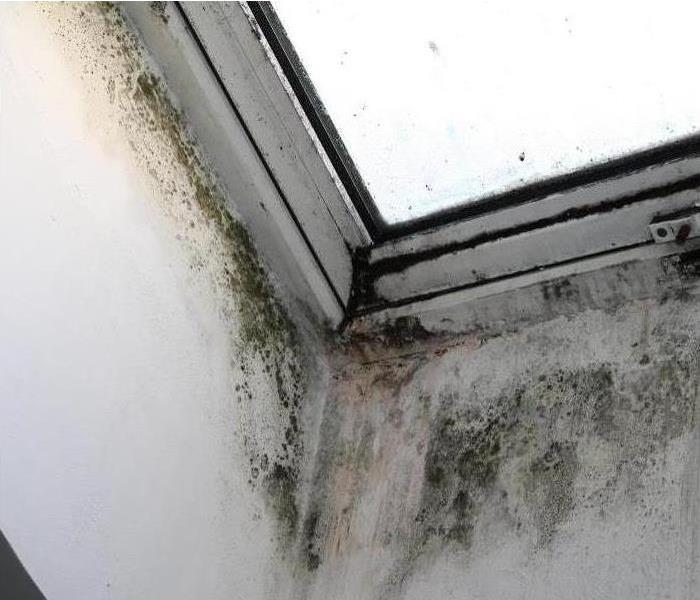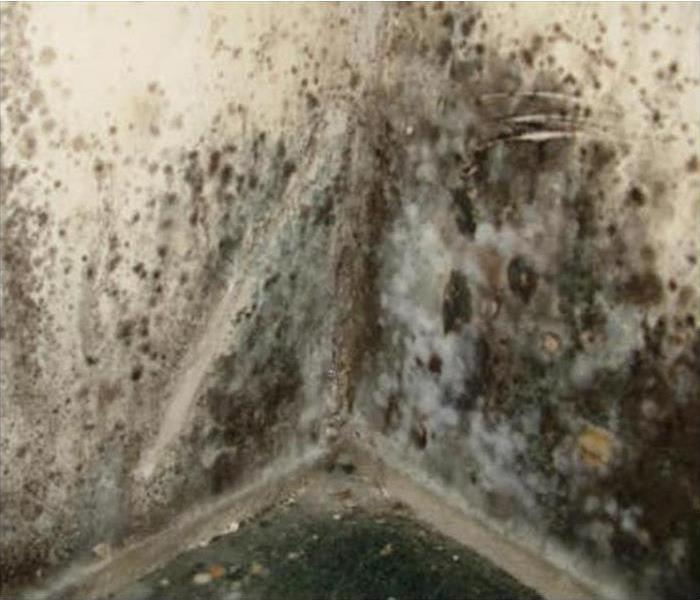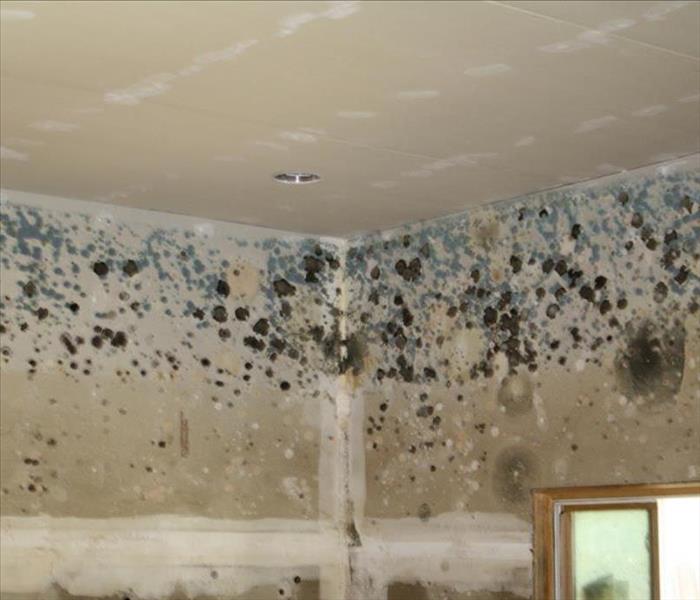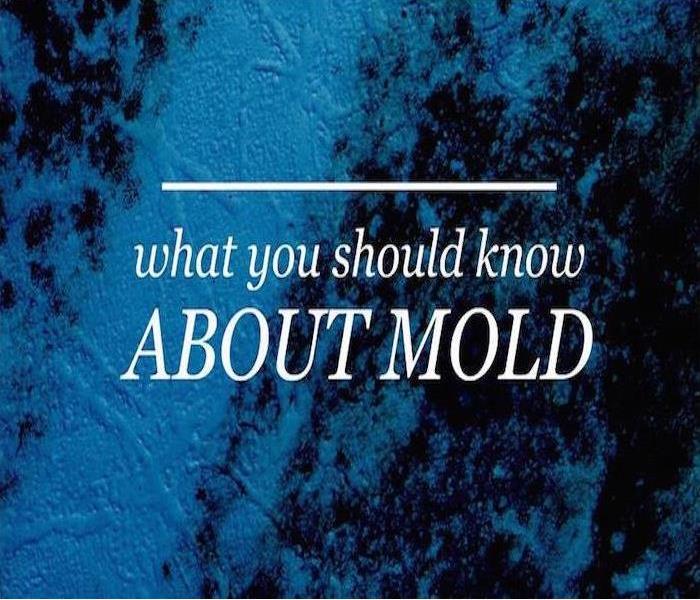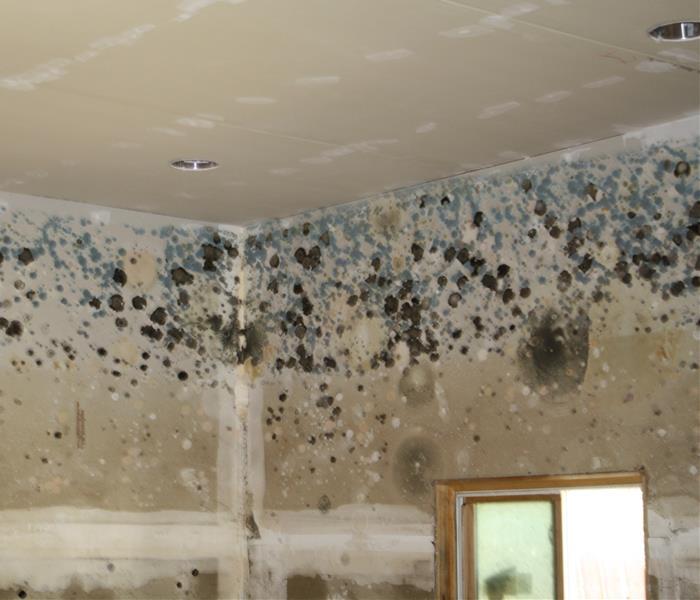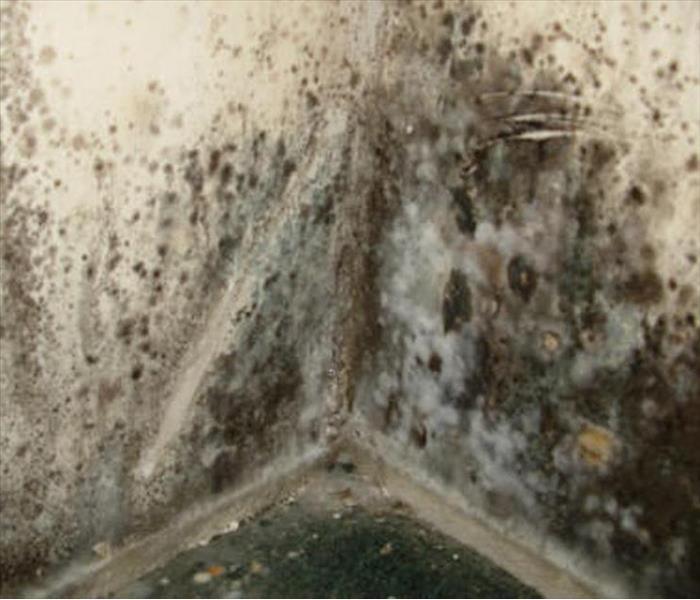Recent Mold Remediation Posts
Mold Prevention
8/1/2018 (Permalink)
Let’s face it, mold is never a good sign in any situation.
It can be extremely costly and hazardous to your health, if it’s growing in your home. We want to share some information with you on how to prevent mold growth in your home. Mold can grow anywhere, with that being said there is no way to completely remove mold. Once mold spores have been disturbed, they travel through the air contaminating other areas. Do not worry, we are here to help should you discover a mold problem. We have a mold specialist on staff to address your mold issues and determine a remediation plan that works the best for you. Give us a call at 803-755-9774 to schedule a site visit. Here are some tips to help prevent mold in your home:
- Identify and fix any problem areas in your home. You can’t mold proof your home, you can make it resistant though. Anywhere moisture is present, mold can grow. If you notice any condensation, water staining on your walls or ceilings, or leaky pipes you need to get it fixed as fast as possible. Sometimes there is moisture or water in areas that you are unaware of, mold can spread very quickly in these conditions.
- Dry any wet areas immediately. If your carpet is wet, make sure your carpet is thoroughly dried. Mold can develop quickly on your carpet and padding and will need to be removed if this happens.
- Prevent as much moisture as possible by using proper ventilation. Your kitchen, bathroom, and laundry room are high moisture areas. Make sure to vent your appliances that can cause moisture. Use dehumidifiers as needed.
- Equip your home with mold resistant products. There are now drywall and paint products that are manufactured with mold inhibitors.
- Inspect your gutters. Clean them out regularly and repair them if need be.
- “Bleaching” mold is not an effective way to get rid of mold, it does just that “bleaches” it. To effectively get rid of mold and mold growth you must use an antimicrobial.
- Having a vapor barrier in your crawl space will prevent moisture and keep mold growth to a slight minimum. If a little mold growth does occur the vapor barrier will also protect your family from the harmful fumes that come from mold.
Can Mold Be Contained During Remediation?
6/25/2018 (Permalink)
Just because you’ve found mold in one room in your home doesn’t mean your entire house is a lost cause. You can still stop the spread of mold contamination during remediation procedures by enacting containment procedures and stopping mold in its tracks.
What Exactly is Mold Containment?
Mold containment essentially involves sealing off the mold infestation so that no spores or growths can escape into other areas of the home and working to eradicate any free-floating spores from the air in un-infested areas. Mold containment during remediation usually involves:
- Identifying the source. Mold won’t stop growing unless you remove the impetus for it to grow, which means removing the water damage feeding it. Identifying the source of leaks and flooding means conducting a thorough home inspection and taking effective remediation activities.
- Sealing the area. You may need to shut off your HVAC systems to prevent mold contamination through the air vents, and fully seal off the area using air-tight methods to prevent further spread of spores. If the mold has penetrated your walls, however, this may be difficult.
- Chemically treating uncontaminated areas. Many mold prevention and mold killer sprays work as an effective preventative treatment and can lay down a barrier that prevents mold from spreading to uncontaminated areas of the house. Determine which mold killer solution is safest for your home, family, and pets before applying it to surfaces in the home.
- Air filtration. While it’s impossible to fully get rid of the billions of mold spores omnipresent in the air always, you can still use air filtration to cleanse the air as much as possible. When you have a mold infestation, the density of spores in the air is much higher – and professional air filtration can at least reduce the density to more reasonable, safe levels.
Many of these steps can be accomplished on your own, or with the aid of professionals. Professionals may be needed if mold contamination has penetrated too deep into the foundations of the home.
Mold Prevention Tips
3/17/2018 (Permalink)
Mold Prevention Tips
- When water leaks or intrusions occur, act quickly! Wet or damp material that is dried within 24 – 48 hours of the leak, in most cases, will NOT grow mold.
- Remove wet carpet or furniture that cannot be dried within 24 – 48 hours.
- Do not install carpet in areas of water usage such as bathrooms, kitchens, and basements.
- Remove wet clothes from the washer promptly.
- Do not leave damp clothes or towels lying around.
- Keep indoor humidity levels below 60%. The ideal level is between 30 – 50%. Relative humidity can be measured by a moisture or humidity meter, a small and inexpensive instrument available at most hardware stores.
- If you see condensation or moisture collecting on windows, walls or pipes, act fast to dry the wet surface and reduce the moisture or water source.
- Use air conditioners or dehumidifiers to keep humidity low.
- Keep air conditioning drip pans clean and the drain lines free of obstructions.
- Be sure dryers, stoves, heaters and exhaust fans vent to the outside, not into the walls or attic.
- Use a bathroom exhaust fan or open the window when you shower.
- Dry shower walls after a shower.
- When cooking or using the dishwasher, use an exhaust fan or open the window.
- Keep furniture from blocking air returns and vents.
- Dust and vacuum often.
- Remove mold growing in the soil of houseplants.
- Clean and repair gutters regularly.
- Repair any roof leaks as soon as you discover them.
- Make sure the ground slopes away from the building foundation so that water does not enter or pool around the foundation.
- Insulate cold surfaces such as cold water pipes to prevent condensation.
- Repair any plumbing leaks as soon as you find them.
- Use mold-resistant building materials when available.
- Install a vapor barrier in the crawlspace to prevent moisture from the ground.
- Keep the crawlspace and basement well ventilated.
- Ensure that the attic is properly ventilated and properly insulated.
If You See Signs of Mold, Call Us Today – (803) 955-0342
Does Homeowners Insurance Cover Mold?
3/17/2018 (Permalink)
Does Homeowners Insurance Cover Mold?
Homeowners insurance does not usually cover mold damages. Although, there are instances when mold is covered. These instances are generally when the cause of mold is due to an incident that homeowners insurance does cover. For example, if mold has grown due to accidental and sudden pipe burst or if a recent fire has caused mold, your homeowners insurance will likely cover the mold damages. On the contrary, if mold has grown due to improper maintenance practices, such as on-going humidity exposure or a continuous leak, homeowners insurance will not likely cover the damages.
If you believe you may have a mold issue give us a call today to have one of our experienced technicians come out and access your concerns!! 803-955-0342
Understanding Mold
3/17/2018 (Permalink)
Understanding Mold
When water intrudes into your property, mold growth can start in as little as 48 hours. Consider the following mold facts:
- Mold is present almost everywhere, indoors and outdoors.
- Mold spores are microscopic, float along in the air, and may enter your home through windows, doors, or AC/heating systems or even hitch a ride indoors on your clothing or a pet.
- Mold spores thrive on moisture. Mold spores can quickly grow into colonies when exposed to water. These colonies may produce allergens and irritants and have the potential to cause other health effects.
- Before mold remediation can begin, any sources of water or moisture must be addressed. Otherwise, the mold may return.
- Mold often produces a strong, musty odor, and that odor can lead you to possible mold problem areas.
- Even higher-than-normal indoor humidity can support mold growth. Keep indoor humidity below 45 percent.
The Truth About Mold
3/7/2018 (Permalink)
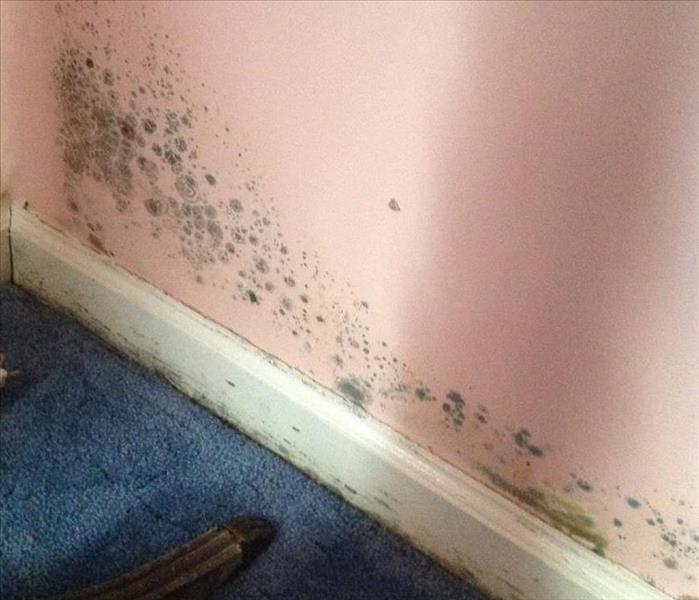 Mold on a wall at a home in Lexington, SC.
Mold on a wall at a home in Lexington, SC.
Mold occurs naturally throughout the environment both indoors and outdoors. In fact, mold spores could be found in nearly every structure in the United States regardless of how new or clean the structure is. That’s because mold in normal amounts is no more dangerous than dust or pollen. Even through some forms of mold can add value to our lives, other forms can be harmful. Excessive amounts of mold, different types of mold or exposure to molds may present health concerns for some people. If there is an ongoing moisture problem in your office, your home or in your customer’s home it is important to be alert for:
-The presence of visible mold.
– Strong, musty odors which may indicate mold is present
-Any evidence of past moisture problems that might have caused mold growth
These conditions may require the expertise of a qualified Indoor Air Quality/ Environmental Professional to inspect the building for mold growth and water damage problems. If you think you or your customer might have a mold problem, check out our website for more information or give us a call: 803955-0342.
Mold Infestation in Lexington, SC.
7/19/2017 (Permalink)
Moisture that was left undetected, caused a mold infestation in this crawl space in a Lexington, SC. home. This before picture shows some of the mold damage that was affecting the crawl space.
SERVPRO of Lexington was called in to clean up and treat the mold problem. The customer was very pleased that we were able to restore their home to normal.
Microscopic mold spores naturally occur almost everywhere, both outdoors and indoors. This makes it impossible to remove all mold from a home or business. Therefore, mold remediation reduces the mold spore count back to its natural or baseline level. Some restoration businesses advertise “mold removal” and even guarantee to remove all mold, which is a fallacy. Consider the following mold facts:
- Mold is present almost everywhere, indoors and outdoors.
- Mold spores are microscopic and float along in the air and may enter your home through windows, doors, or AC/heating systems or even hitch a ride indoors on your clothing or a pet.
- Mold spores thrive on moisture. Mold spores can quickly grow into colonies when exposed to water. These colonies may produce allergens and irritants.
- Before mold remediation can begin, any sources of water or moisture must be addressed. Otherwise, the mold may return.
- Mold often produces a strong, musty odor and can lead you to possible mold problem areas.
- Even higher-than-normal indoor humidity can support mold growth. Keep indoor humidity below 45 percent.
If your home or business has a mold problem, we can inspect and assess your property and use our specialized training, equipment, and expertise to remediate your mold infestation.
If You See Signs of Mold, Call Us Today – (803) 955-0342
Does Your Lexington Home Have A Mold Problem?
6/20/2017 (Permalink)
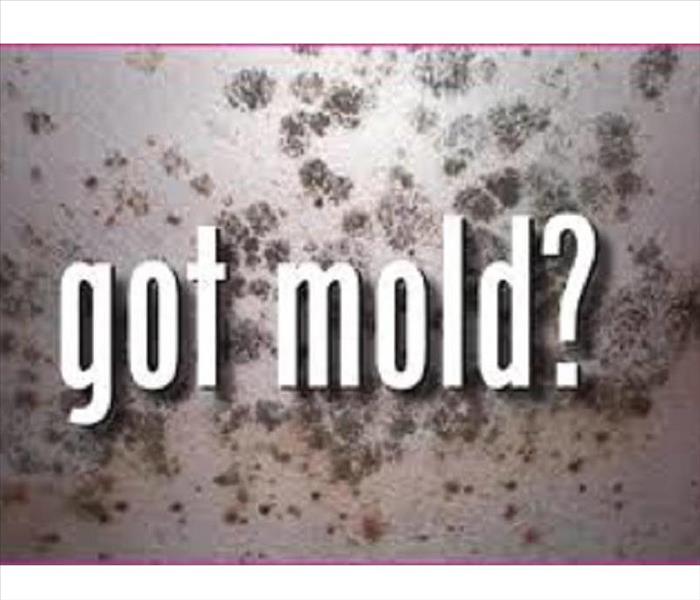 In Lexington, mold can spread through a home in as little as 48 hours.
In Lexington, mold can spread through a home in as little as 48 hours.
Does Your Lexington Home Have A Mold Problem?
Microscopic mold spores naturally occur almost everywhere, both outdoors and indoors. This makes it impossible to remove all mold from a home or business. Therefore, mold remediation reduces the mold spore count back to its natural or baseline level. Some restoration businesses advertise “mold removal” and even guarantee to remove all mold, which is a fallacy. Consider the following mold facts:
- Mold is present almost everywhere, indoors and outdoors.
- Mold spores are microscopic and float along in the air and may enter your home through windows, doors, or AC/heating systems or even hitch a ride indoors on your clothing or a pet.
- Mold spores thrive on moisture. Mold spores can quickly grow into colonies when exposed to water. These colonies may produce allergens and irritants.
- Before mold remediation can begin, any sources of water or moisture must be addressed. Otherwise, the mold may return.
- Mold often produces a strong, musty odor and can lead you to possible mold problem areas.
- Even higher-than-normal indoor humidity can support mold growth. Keep indoor humidity below 45 percent.
If your home or business has a mold problem, we can inspect and assess your property and use our specialized training, equipment, and expertise to remediate your mold infestation.
If You See Signs of Mold, Call Us Today – (803)955-0342
Does Your Lexington Home have A Mold Problem?
6/12/2017 (Permalink)
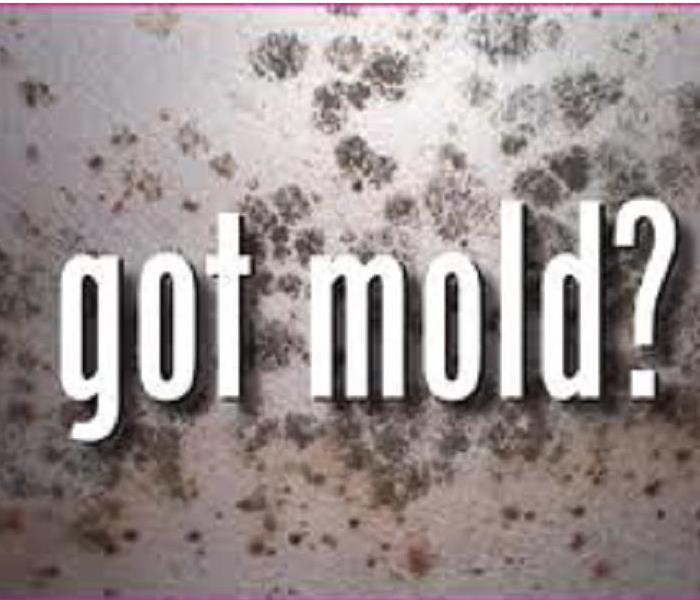 In Lexington, mold can spread through a home in as little as 48 hours.
In Lexington, mold can spread through a home in as little as 48 hours.
Does Your Lexington Home Have A Mold Problem?
Microscopic mold spores naturally occur almost everywhere, both outdoors and indoors. This makes it impossible to remove all mold from a home or business. Therefore, mold remediation reduces the mold spore count back to its natural or baseline level. Some restoration businesses advertise “mold removal” and even guarantee to remove all mold, which is a fallacy. Consider the following mold facts:
- Mold is present almost everywhere, indoors and outdoors.
- Mold spores are microscopic and float along in the air and may enter your home through windows, doors, or AC/heating systems or even hitch a ride indoors on your clothing or a pet.
- Mold spores thrive on moisture. Mold spores can quickly grow into colonies when exposed to water. These colonies may produce allergens and irritants.
- Before mold remediation can begin, any sources of water or moisture must be addressed. Otherwise, the mold may return.
- Mold often produces a strong, musty odor and can lead you to possible mold problem areas.
- Even higher-than-normal indoor humidity can support mold growth. Keep indoor humidity below 45 percent.
If your home or business has a mold problem, we can inspect and assess your property and use our specialized training, equipment, and expertise to remediate your mold infestation.
If You See Signs of Mold, Call Us Today – (803)955-0342.
The Truth about Mold
3/20/2017 (Permalink)
The Truth about Mold
Mold is a type of fungus that consists of small organisms found almost everywhere. Mold can be black, white, orange, green, or purple. Mold plays a very important role in nature- it helps break down dead leaves, plants, and trees. We are exposed to mold daily, meaning removing all mold is impossible.
In small amounts, mold spores are usually harmless, but when they find a damp spot in your home or business, mold may begin to grow.
Mold can spread quickly, in as little as 48 hours. Mold spores are microscopic and float along in the air and may enter your home or business through windows, doors, or AC/ heating systems. Mold often produces a strong, musty odor.
Mold can cause health effects and can also cause significant damage to your property. If mold is found, SERVPRO of Cayce/ West Columbia and Lexington has the training, equipment, and expertise to remediate your mold infestation.
Before mold remediation can begin, any sources of water or moisture must be taken care of, or the mold will return.
Your property will be carefully inspected for signs of mold using technology designed to detect mold and hidden water sources. The mold remediation process depends on the amount of mold growth and the types of surfaces on which the mold appears. Restoration may involve minor repairs, such as replacing drywall, painting, and installing new carpet; or it may entail major repairs such as the reconstruction of various areas in your home or business.
Here is a helpful list of specific recommendations to limit your chance of getting mold:
- Keep humidity levels as low as you can- no higher than 50%.
- Use an air conditioner or a dehumidifier during humid months.
- Be sure the home has adequate ventilation.
- Add mold inhibitors to paints before application.
- Clean bathrooms with mold killing products.
- Do not carpet bathrooms and basements.
- Remove or replace previously soaked carpets and upholstery.
Every mold damage is different and requires different solutions. SERVPRO of Cayce/ West Columbia and Lexington understands mold and mold growth, we are trained mold damage specialist who get started quickly to get your home, “Like it never even happened.”
5 steps to Mold Remediation
8/16/2016 (Permalink)
Five steps that each mold-removal specialist takes when conducting mold remediation includes:
- Determine the degree of contamination. The first step for a mold remediation specialist to determine the extent of the mold damage and test for contamination within the facility. Because mold spores and other microscopic contaminants can travel easily throughout a building, they may collect and analyze samples from affected as well as unaffected areas of the building. Once finished the inspection they will develop a remediation plan for the mold removal specialist with steps to return the home to its pre-loss condition (Condition 1).
- Set up and verify containment. To make sure mold contamination does not spread to other areas of a facility, the mold remediation specialist will set up containment by creating isolation barriers. Once the barriers are set up, the specialist will need to verify the containment with a lower partial pressure differential (negative pressure) to ensure there is no air leakage between containment zones. Exit chambers would then be used to serve as a transition between the containment and the unaffected area of the building. Once the containment is verified and the correct amount of pressure is achieved, the removal process can begin.
- Remove non-salvageable materials. Porous materials and items that cannot be restored or cleaned effectively must be carefully discarded. Non-salvageable items include but are not limited to drywall, insulation and other items with visible mold growth. It is important for the specialist to wear the appropriate personal protective equipment which may include a full face respirator, disposable coveralls and nitrile gloves.
- Clean surfaces with a high-attention to detail. A mold remediation specialist will likely begin the cleaning process by thoroughly vacuuming the contaminated areas using a HEPA vacuum with a high-efficiency filter to catch mold spores. He or she will then begin a detailed cleaning process involving mold removal tools such as a HEPA filtered sander, followed by the damp wiping of surfaces with an effective cleaning solution.
- Verify remediation. Once cleaning is complete, and verify the remediation was successful. The area must be returned to the dry standard and should be visually dust free with no malodor.
Mold remediation requires mold removal specialists to perform techniques that promote source removal rather than relying on chemicals, paints and coatings as a replacement. Understanding and managing air flow is also critical to the success of a mold remediation project.
Returning home after Summer break or Vacations
8/3/2016 (Permalink)
The spring semester ends and students head home to visit with friends and families. When they leave their apartment, home, townhome, or condo, they assume that upon their return everything will be just as they left it. That, unfortunately, is not always the case.
With the return of college students and summer vacationers alike, we have had a massive influx in mold remediation jobs. People return to their homes to either find their walls, floors and belongings covered in mold. Most have no idea what caused it or what to do next! That's where we come in.
Primary causes of Mold growth include but are certainly not limited to: water intrusion, the improper dry out of water damage, flooding, high humidity levels, and a broken or turned off air conditioning unit. In the case of a home that is left empty for the summer, finding mold upon returning is very common. In general, the cause is a turned off air conditioning unit. NEVER turn off your air conditioner. South Carolina has an extremely high humidity level. A high humidity level is the perfect condition for mold growth. An air conditioner set at 78 degrees Fahrenheit, at the very highest, will keep the cost of your electrical bill low all while circulating the air in your home and preventing mold growth.
The second most common cause behind mold growth is an unknown water intrusion. If you plan to leave your home empty over the summer, have a friend or neighbor whom you trust periodically stop by to monitor the condition of your home. For example, we experienced plenty of heavy rainfall this summer, as Florida normally does. What if you have any unknown leak in your roof? Water damage will occur. Unfortunately if no one is in the home to catch this, the water damage will only get worse. The wet walls, flooring, etc. are breeding grounds for mold. While you are away enjoying your summer, mold is infesting your home. But sometimes, you don't even have to have an uninhabited home for this to occur! If water damage occurs in your home, whether it be from indoor or outdoor sources, handle it properly. Water damage that is not dried properly will result in mold. Water mitigation might not be the cheapest process, but mold remediation can certainly be more expensive. The longer water damage lingers without being handled properly, the more damage that is created.
F.U.N.G.I
7/18/2016 (Permalink)
While there are many differences between the two fungi, mold and mildew both develop and thrive in moist conditions. A leaking roof, a window that doesn’t seal properly, and a basement with water damage caused by a broken pipe can all lead to the growth of mildew and mold. In order to reduce the risk of health effects and damage to building materials, mildew and mold in the home or a business need immediate mold remediation.
Mildew vs Mold
Plain and simple, mildew and mold are fungi. Fungi can live in many different types of habitats such as in soil, on vegetation, and on surfaces exposed to moist conditions like a wall or ceiling after flood damage. Fungi reproduce by spores and quickly can spread.
What is mildew? Mildew is mold in its early stage and often the term is used interchangeably with the word mold. That whitish-gray, powdery substance sometimes seen on the leaves of a plant is mildew. Mildew is a surface fungi that grows on organic material like plants and food as well as wood or fibrous items like:
DrywallInsulationCardboard/paperboardWallpaperFabricHow is it different from Mold? Mold ranges in color from green to gray, brownish and black. It may appear fuzzy, flat or even slimy. Green slimy mold may develop in the damp, shady areas of decks and even vinyl siding, while indoors, mold can develop on grout, tile and other surfaces found in and around bathrooms and other areas with high humidity and inadequate ventilation.
Pro Tip: Slimy mold on decks, fences and siding often can be removed using a pressure washer. Always wear proper safety protection when dealing with mold and working with tools.
Dangers of Mildew and Mold
In a battle between mildew vs mold, which presents more problems and danger? It depends on several factors.
The powdery mildew often found on the leaves of a houseplant, typically poses little danger to you, but it can harm the plant. However, anyone that suffers from mold allergies should avoid touching that mildew. If contact occurs, wash hands thoroughly and never touch your face/eyes/nose after coming in contact with mildew.
The Need for Mold Remediation
Mold and mildew, if ignored, can cause long-term health issues and physical damage to a home or business. Mold found anywhere in a building, such as behind drywall, on insulation, around windows and along basement walls has developed because there is a moisture problem. To avoid further damage, it’s essential to locate and correct the source of the moisture and then remove all traces of mold.
Any home or business that’s suffered any type of water damage (from firefighting efforts, roof leak, burst pipe or flood) needs professional assessment quickly. Contact SERVPRO of Lexington immediately after any water disaster; mold can begin developing within 24 to 48 hours. Trust our professional technicians for a comprehensive mold remediation plan. Call (803) 755-9774.
Does Your Lexington, Cayce/ West Columbia Home Have A Mold Problem?
4/27/2016 (Permalink)
April 25th – May 1st is Allergy Awareness Week. Allergens are caused by many things including microscopic mold spores. They naturally occur almost everywhere, both outdoors and indoors. This makes it impossible to remove all mold from a home or business. Therefore, mold remediation reduces the mold spore count back to its natural or baseline level. Some restoration businesses advertise “mold removal” and even guarantee to remove all mold, which is a fallacy. Consider the following mold facts:
Mold is present almost everywhere, indoors and outdoors.Mold spores are microscopic and float along in the air and may enter your home through windows, doors, or AC/heating systems or even hitch a ride indoors on your clothing or a pet.Mold spores thrive on moisture. Mold spores can quickly grow into colonies when exposed to water. These colonies may produce allergens and irritants.Before mold remediation can begin, any sources of water or moisture must be addressed. Otherwise, the mold may return.Mold often produces a strong, musty odor and can lead you to possible mold problem areas.Even higher-than-normal indoor humidity can support mold growth. Keep indoor humidity below 45 percent.If your home or business has a mold problem, we can inspect and assess your property and use our specialized training, equipment, and expertise to remediate your mold infestation.
If You See Signs of Mold, Call Us Today – (803) 755-9774
Mold, Moisture and your home
2/17/2016 (Permalink)
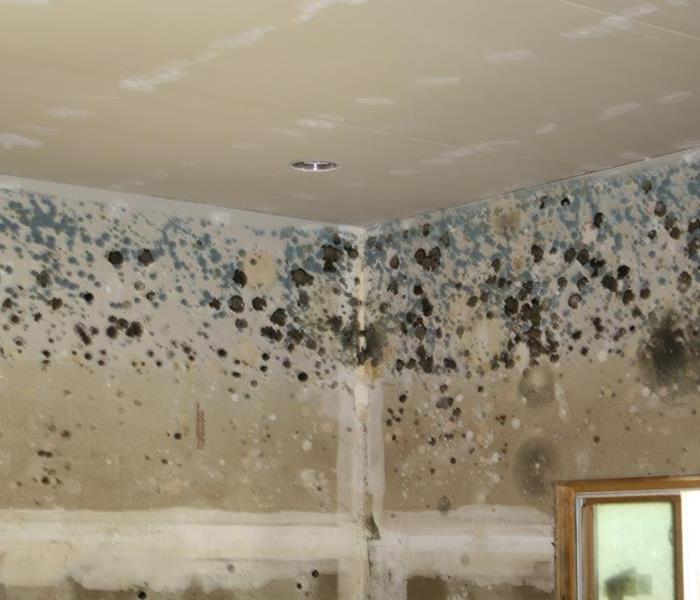 Picture and Content Credit: enlightenme.com and nachi.org
Picture and Content Credit: enlightenme.com and nachi.org
Mold, Moisture and Your Home
Mold Basics
The key to mold control is moisture control.
If mold is a problem in your home, you should clean up the mold promptly and fix the water problem.
It is important to dry water-damaged areas and items within 24 to 48 hours to prevent mold growth.
Why is mold growing in my home?
Molds are part of the natural environment. Outdoors, molds play a part in nature by breaking down dead organic matter, such as fallen leaves and dead trees. But indoors, mold growth should be avoided. Molds reproduce by means of tiny spores; the spores are invisible to the naked eye and float through outdoor and indoor air. Mold may begin growing indoors when mold spores land on surfaces that are wet. There are many types of mold, and none of them will grow without water or moisture.
Who should do the cleanup?
This depends on a number of factors. One consideration is the size of the mold problem. If the moldy area is less than about 10 square feet (less than roughly a 3-foot by 3-foot patch), in most cases, you can handle the job yourself, following the guidelines below.
If there has been a lot of water damage, and/or mold growth covers more than 10 square feet, consult SERVPRO.
If you choose to hire a contractor (or other professional service provider- SERVPRO) to do the cleanup, make sure the contractor has experience cleaning up mold. Check references and ask the contractor to follow the recommendations of the EPA, the guidelines of the American Conference of Governmental Industrial Hygienists (ACGIH), or other guidelines from professional or government organizations.
Do not run the HVAC system if you know or suspect that it is contaminated with mold. This could spread mold throughout the building.
If the water and/or mold damage was caused by sewage or other contaminated water, then call in a professional who has experience cleaning and fixing buildings damaged by contaminated water.
Moisture and Mold Prevention and Control Tips:
Moisture control is the key to mold control, so when water leaks or spills occur indoors, ACT QUICKLY. If wet or damp materials or areas are dried within 24 to 48 hours after a leak or spill happens, in most cases, mold will not grow.
Clean and repair roof gutters regularly.
Make sure the ground slopes away from the building's foundation so that water does not enter or collect around the foundation.
Keep air-conditioning drip pans clean and the drain lines unobstructed and flowing properly.
Keep indoor humidity low. If possible, keep indoor humidity below 60% relative humidity (ideally, between 30% to 50%). Relative humidity can be measured with a moisture or humidity meter, which is a small, inexpensive instrument (from $10 to $50) that is available at many hardware stores.
If you see condensation or moisture collecting on windows, walls or pipes, ACT QUICKLY to dry the wet surface and reduce the moisture/water source. Condensation can be a sign of high humidity.
Actions that will help to reduce humidity:
Vent appliances that produce moisture, such as clothes dryers, stoves, and kerosene heaters, to the outdoors, where possible. (Combustion appliances, such as stoves and kerosene heaters, produce water vapor and will increase the humidity unless vented to the outside.)
Use air conditioners and/or de-humidifiers when needed.
Run the bathroom fan or open the window when showering. Use exhaust fans or open windows whenever cooking, running the dishwasher or dishwashing, etc.
Actions that will help prevent condensation:
Reduce the humidity (see above).
Increase ventilation and air movement by opening doors and/or windows, when practical. Use fans as needed.
Cover cold surfaces, such as cold water pipes, with insulation.
Increase air temperature.
Things You Should Know About Mold
1. There is no practical way to eliminate all mold and mold spores in the indoor environment; the way to control indoor mold growth is to control moisture.
2. If mold is a problem in your home, you must clean up the mold and eliminate sources of moisture.
3. Fix the source of the water problem or leak to prevent mold growth.
4. Reduce indoor humidity (to 30% to 60%) to decrease mold growth by:
a. venting bathrooms, dryers, and other moisture-generating sources to the outside;
b. using air conditioners and de-humidifiers;
c. increasing ventilation; and
d. using exhaust fans whenever cooking, dishwashing, and cleaning.
5. Clean and dry any damp or wet building materials and furnishings within 24 to 48 hours to prevent mold growth.
6. Clean mold off hard surfaces with water and detergent, and dry completely. Absorbent materials that are moldy (such as carpeting and ceiling tiles) may need to be replaced.
7. Prevent condensation. Reduce the potential for condensation on cold surfaces (i.e., windows, piping, exterior walls, roof and floors) by adding insulation.
8. In areas where there is a perpetual moisture problem, do not install carpeting.
9. Molds can be found almost anywhere; they can grow on virtually any substance, provided moisture is present. There are molds that can grow on wood, paper, carpet, and foods.
Top 10 Tips for Preventing Mold after Your Home is Water Damaged
When a home is flooded, due to either a natural disaster or a major water leak within the house, mold can set in fairly fast, sometimes in as little as 48 hours.
1. Open all windows and doors to increase ventilation and help dry things out. If you have power and you know it is safe to use, set up fans to speed up the process.
2. Wall to wall carpeting and padding should be removed and thrown away. Wet carpeting may be very slow to dry and can ruin the floor underneath.
3. Upholstered furniture, mattresses and pillows should be disposed of. These are very hard to clean completely and can take a long time to dry and this is exactly the conditions that mold needs to take hold.
4. If the wallboard has come in contact with water, it will need to be removed. Wet wallboard will swell and deteriorate and mold can set in very quickly.
5. Dispose of any wet books and papers that aren’t valuable. Make copies of important documents and throw the originals away if possible.
6. Mop vinyl or ceramic floors with a disinfecting cleaner. Make sure that the underlayment is dry.
7. Wash draperies and curtains or have them dry cleaned according to the manufactures’ instructions.
8. Remove as much moisture from hardwood floors as soon as possible. Use fans and dehumidifiers to speed up the process but avoid using heat as it may cause the floor to warp.
9. If ceiling tiles are wet, remove and discard them. Allow the space to dry and air out completely before installing a new ceiling.
10. You may need to hire a water remediation service if the damage is extensive so the house can be dried out as soon as possible. Remember that when it comes to preventing mold, the sooner you can tackle the water damage the better chance you have of preventing mold.
DO NOT LET MOLD BE YOUR ROOMATE
4/10/2015 (Permalink)
Health and safety risks are essential to ensuing liveliness for the construction of your business or home. This includes taking proper attempt to solve already existing problem and having proper preventative measures to avoid any issues. growth of mold, particularly black mold requires huge proactive actions to prevent your health and building occupants. Get rid of mold at the first indication of growth instead of allowing it to affect structure of your building and your health.
Performing regular inspection for mold and taking suitable mold mitigations is the ideal way to maintain your commercial or residential property as protected as possible. It is best to have regular professional inspection to identify mold formation, but there are a few sigs that can make you aware about the mold growth on the building. These include:
PuddlesMusty smellsMoist spots on ceiling floorContinuous incoming waterVisible mildew or mold spotsIf your building structure shows any of the above listed signs, it is essential to take instant action before situation spread or worsen.
Mild growth can affect your health particularly the respiratory. If you have any breathing problems in your home recently, it is a sign of mold growth in the home. Mold particularly black mold or Stachybotrys are allergen for people and can cause respiratory disorder. Symptoms include:
Runny noseWheezingCoughingSneezingHiring a professional is the permanent solution for mold removal. Even though the mold removal companies charge a little more the result would be worth your spending. The professional mold remediation process involves the following:
Sealing off the mold affected area in order to prevent it from spreading.Scraping the patches of mold and clean the affected region thoroughly.Pinpointing the moisture source that leads mold formation.Discussing the waterproofing option.SERVPRO is the best company that provides great support in mold remediation.
NOBODY HAS TIME FOR MOLD
4/8/2015 (Permalink)
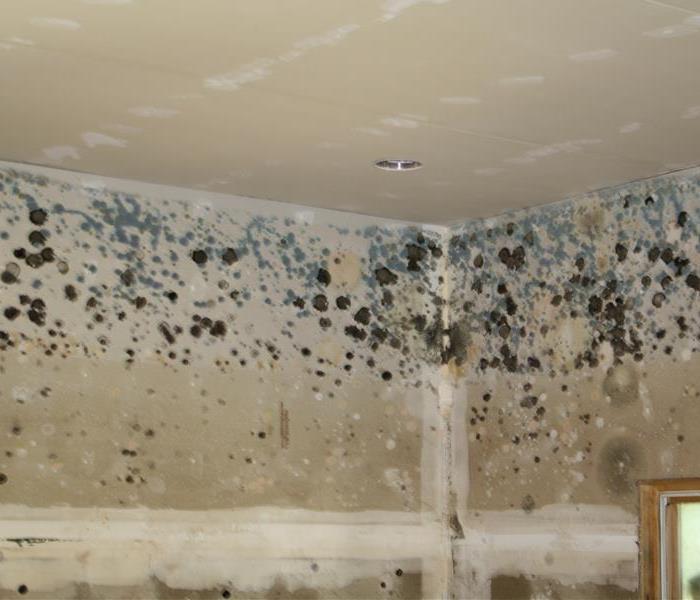 PHOTO CREDIT: baney construction
PHOTO CREDIT: baney construction
With the recent heavy rains and thunderstorms, it has caused a lot of damage to roofs as well as ground water in basements. We have been extremely busy keeping up with thte damage these sorms have caused. some people, who had water in their basements and attics, are now experiencing mold provlems. Mold can begin to grow withtin 48-72 hours of a water damage issue. If you have water in the basement or attic your should definitely contact a professional water mitigation company to assess the damge. The longer it waits the more expensive the cleanup can get.
The Truth About Mold
9/25/2013 (Permalink)
Mold spores are everywhere in our environment and can enter homes easily. Most types of mold grow quickly if they have a water source, an organic food source and temperatures between 60 and 86 Fahrenheit.
An Institute of Medicine study found excessive dampness indoors is a public health problem by encouraging growth of molds, dust mites and other organisms.
The Truth About Mold
7/24/2013 (Permalink)
Mold occurs naturally throughout the environment both indoors and outdoors. In fact, mold spores could be found in nearly every structure in the United States regardless of how new or clean the structure is. That’s because mold in normal amounts is no more dangerous than dust or pollen. Even through some forms of mold can add value to our lives, other forms can be harmful. Excessive amounts of mold, different types of mold or exposure to molds may present health concerns for some people. If there is an ongoing moisture problem in your office, your home or in your customer’s home it is important to be alert for:
- The presence of visible mold.
- Strong, musty odors which may indicate mold is present
- Any evidence of past moisture problems that might have caused mold growth
These conditions may require the expertise of a qualified Indoor Air Quality/ Environmental Professional to inspect the building for mold growth and water damage problems. If you think you or your customer might have a mold problem, check out our website for more information or give us a call: 803-755-9774.

 24/7 Emergency Service
24/7 Emergency Service
